Mastering MySQL Aggregate Functions: Simplifying Data Analysis
In today’s world of data-driven decision-making, efficiency and precision are key to success. MySQL’s aggregate functions are powerful tools that allow users to quickly compute, analyze, and summarize data. This article will introduce you to MySQL aggregate functions, making complex data operations simple and efficient.
Tools:
-Database: MySQL community 8.1
-GUI:SQLynx Pro 3.5.0
Sample Data:
CREATE TABLE student_score ( id INT PRIMARY KEY, name VARCHAR(50), subject VARCHAR(50), score INT ); INSERT INTO student_score (id, name, subject, score) VALUES (1, 'Tom', 'Math', 80), (2, 'Tom', 'English', 90), (3, 'Tim', 'English', 98), (4, 'Alice', 'Math', 85), (5, 'Alice', 'English', 87), (6, 'Bob', 'Math', 78), (7, 'Bob', 'Science', null), (8, 'Charlie', 'History', 92), (9, 'Charlie', 'Math', 81), (10, 'Diana', 'English', 93);
1. COUNT()
- Purpose: Returns the number of rows that match a specified condition.
- Note: COUNT(*) counts all rows, including those with NULL values. COUNT(column) counts non-NULL values in the specified column.
- Example:
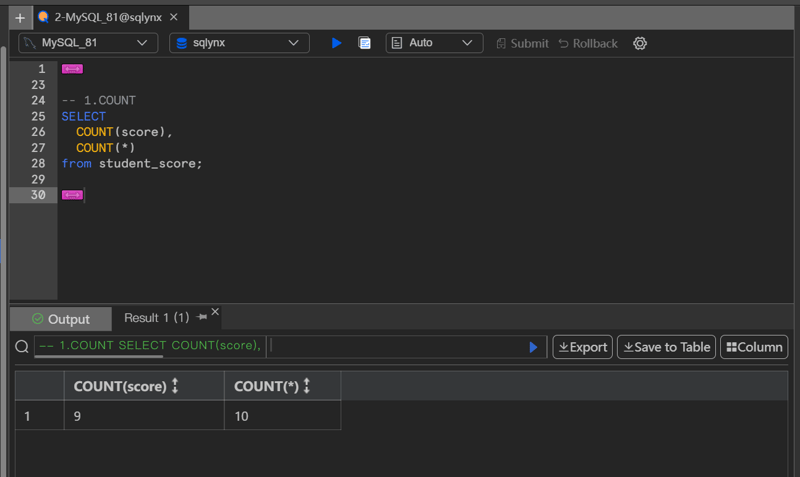
2. SUM()
- Purpose: Returns the sum of values in a numeric column.
- Note: Only non-NULL values are included in the sum. If all values are NULL, it returns NULL.
- Example:
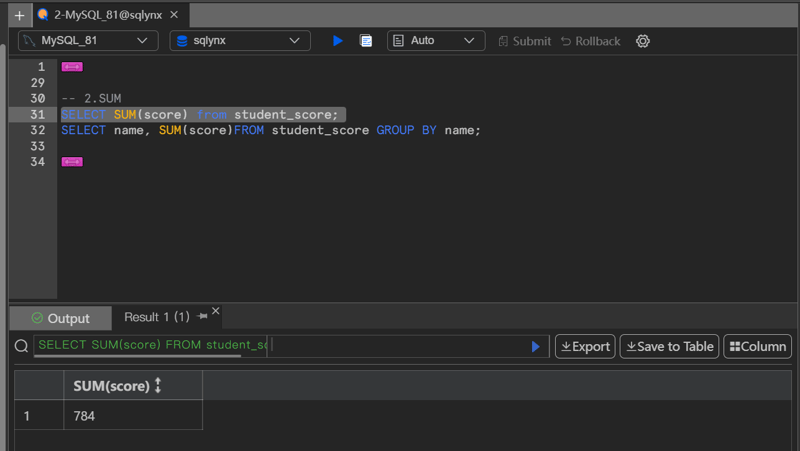
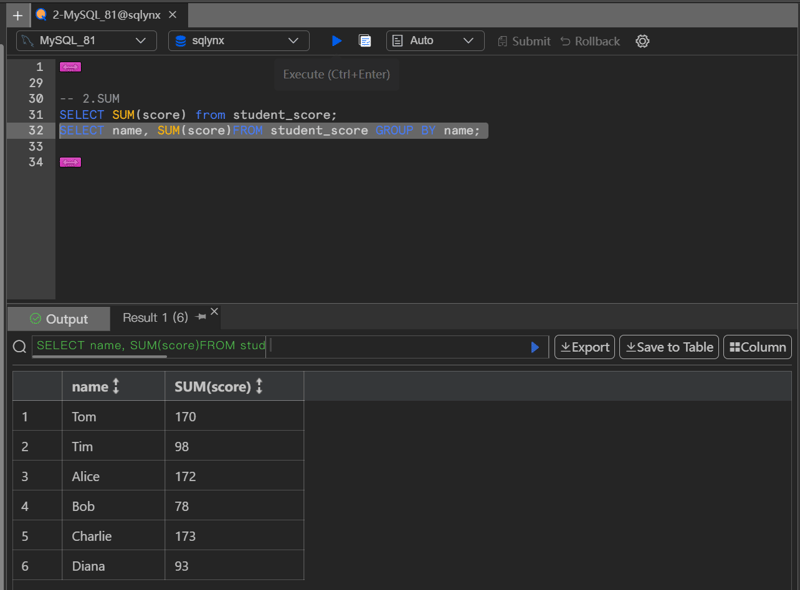
3. AVG()
- Purpose: Calculates the average value of a numeric column.
- Note: Only non-NULL values are considered. AVG() returns NULL if there are no non-NULL values.
- Example:
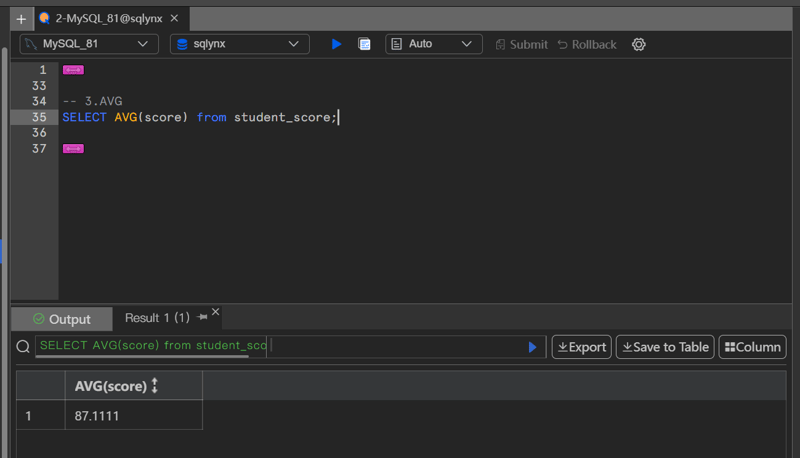
4. MAX()
- Purpose: Returns the maximum value from a column.
- Note: Works with numeric, date, and string types. Ignores NULL values.
- Example:
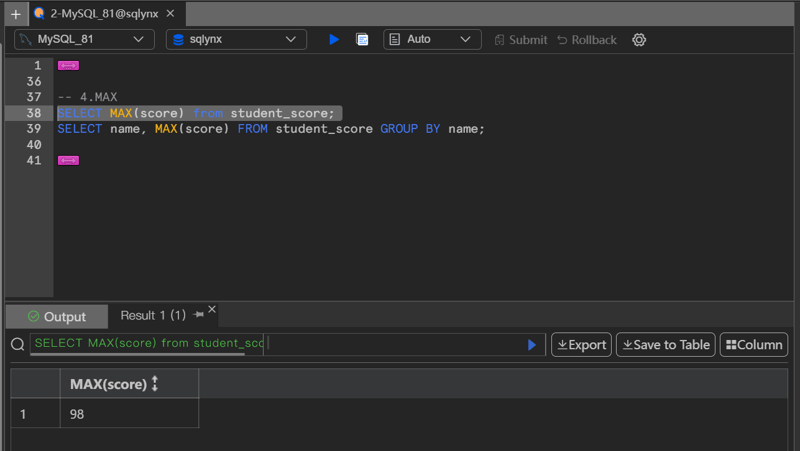
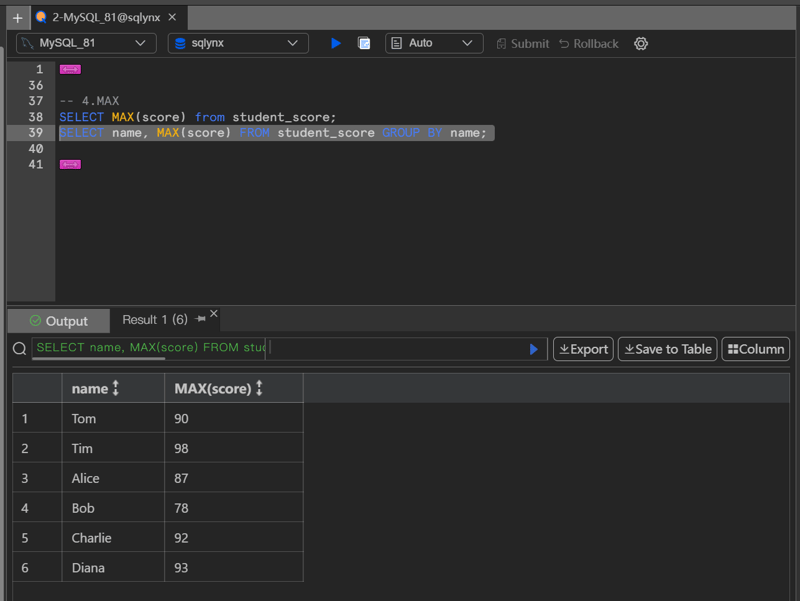
5. MIN()
- Purpose: Returns the minimum value from a column.
- Note: Like MAX(), it works with numeric, date, and string types, and ignores NULL values.
- Example:
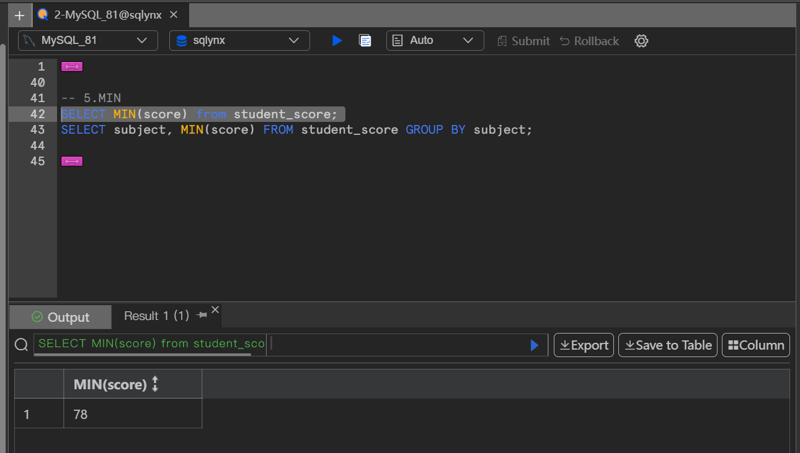
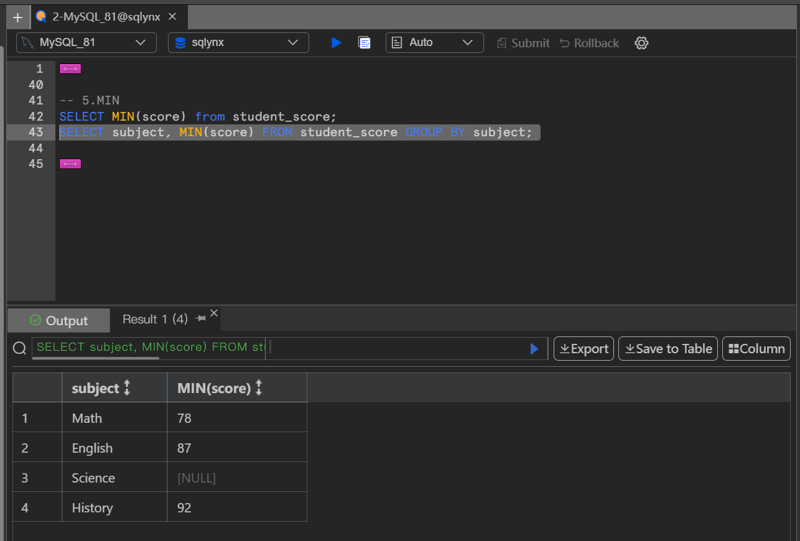
6. GROUP_CONCAT()
- Purpose: Concatenates values from a column into a single string, with an optional separator.
- Note: Useful for aggregating strings from different rows into one. You can specify a separator (default is a comma). Only non-NULL values are concatenated.
- Example:
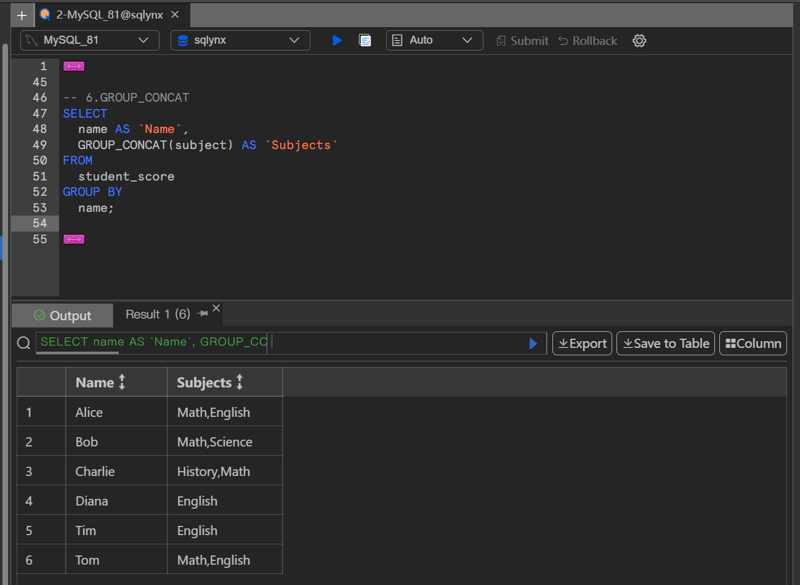
7. JSON_ARRAYAGG()
- Purpose: Aggregates values from multiple rows into a JSON array.
- Note: It converts the result set of a column into a JSON array. Only non-NULL values are included in the resulting array.
- Example:
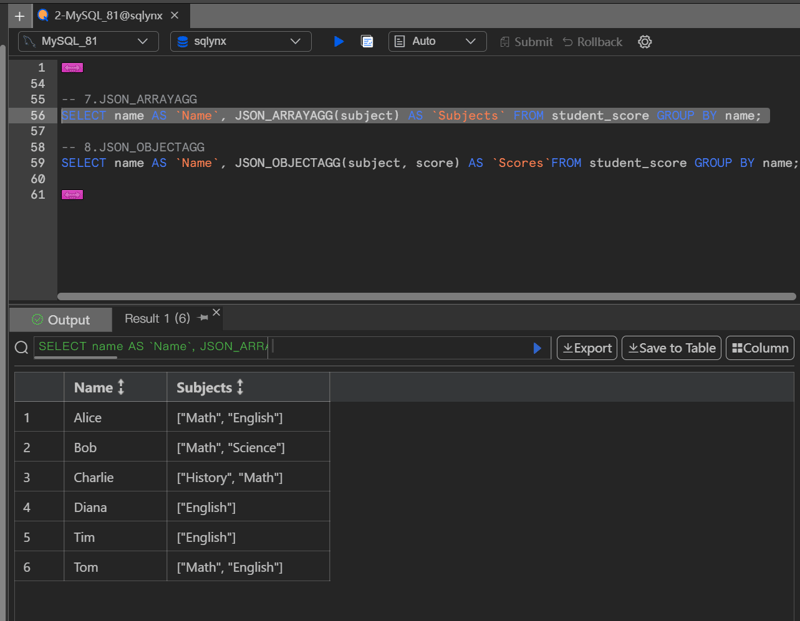
8. JSON_OBJECTAGG()
- Purpose: Aggregates key-value pairs from multiple rows into a JSON object.
- Note: The first argument provides the keys, and the second provides the values for the resulting JSON object. Only non-NULL key-value pairs are included in the result.
- Example:

9. STD()
- Purpose: Computes the standard deviation of a numeric column, reflecting the amount of variation or dispersion in the dataset.
- Note: Both STD() and STDDEV() are aliases for STDDEV_POP(), which calculates the population standard deviation. Only non-NULL values are considered. If you need to compute the sample standard deviation, use STDDEV_SAMP().
- Example:

10. STD_SAMP()
- Purpose: Calculates the sample standard deviation of a numeric column, providing a measure of how spread out the values are in a sample dataset.
- Note: Only non-NULL values are considered. Unlike STD() or STDDEV(), which calculate the population standard deviation, STD_SAMP() is specifically used for sample data, dividing by n-1 to account for sample size bias.
- Example:

11. VAR_POP()
- Purpose: Calculates the population variance of a numeric column, measuring how data points in the entire population are spread out.
- Note: Only non-NULL values are considered. VAR_POP() is used when the data represents the entire population, dividing by n (the total number of data points).
- Example:
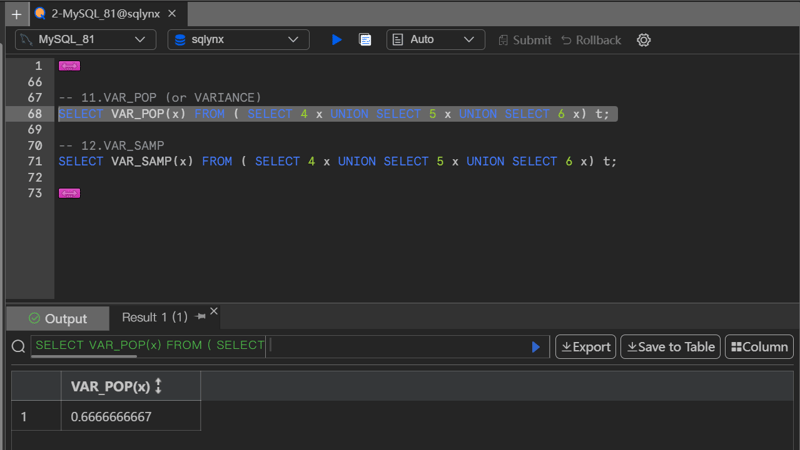
12. VAR_SAMP()
- Purpose: Calculates the sample variance of a numeric column, measuring how data points in a sample are spread out.
- Note: Only non-NULL values are considered. VAR_SAMP() is used when the data represents a sample of the population, dividing by n-1 to adjust for sample size and avoid bias.
- Example:
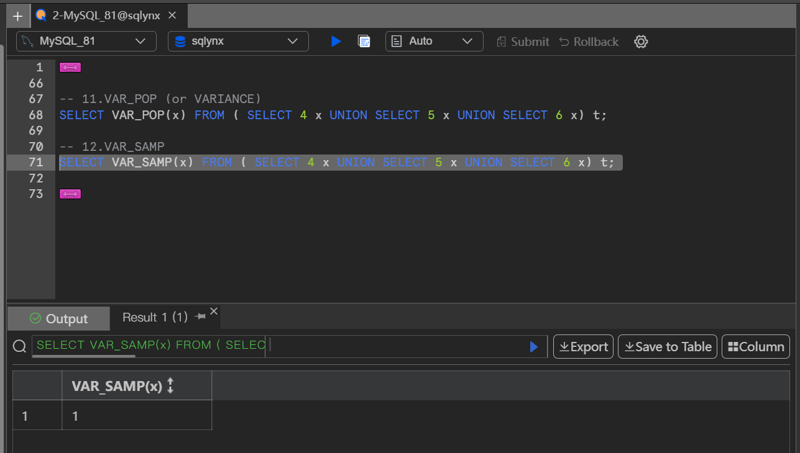
13. BIT_AND()
- Purpose: Returns the bitwise AND of all values in a column.
- Note: Works on integer values and ignores NULL entries.
- Example:
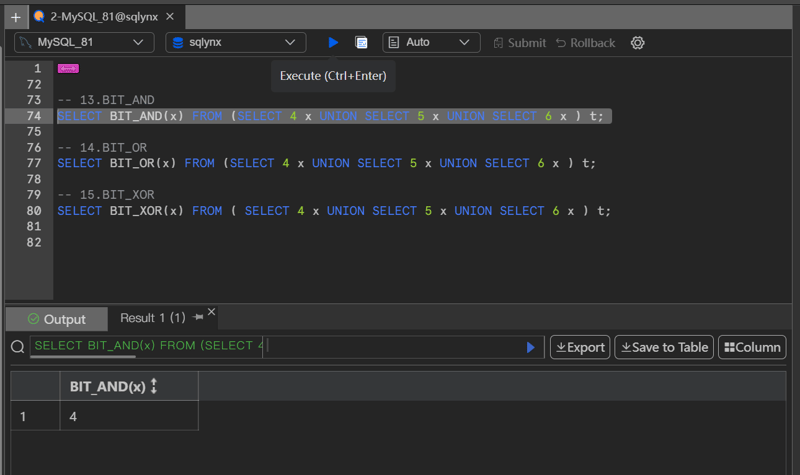
14. BIT_OR()
- Purpose: Returns the bitwise OR of all values in a column.
- Note: Similar to BIT_AND(), it operates on integers.
- Example:
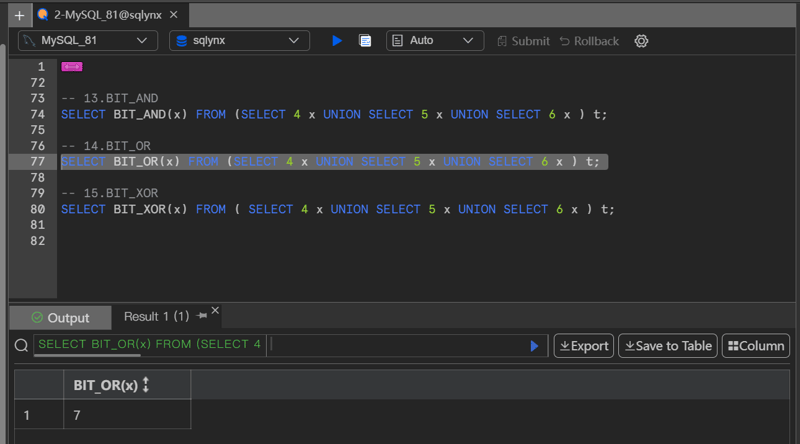
15. BIT_XOR()
- Purpose: Returns the bitwise XOR of all values in a column.
- Note: Bitwise XOR can be useful for parity checks or similar tasks.
- Example:
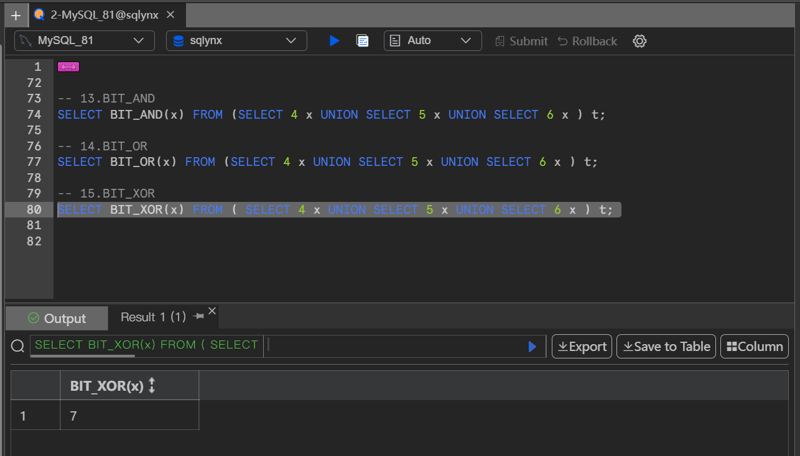
These aggregate functions provide powerful ways to summarize, calculate, and manipulate data, making them essential tools in data analysis and reporting. When using them, consider how they handle NULL values and be aware of the specific SQL mode or MySQL version requirements (e.g., JSON functions).
The above is the detailed content of Mastering MySQL Aggregate Functions: Simplifying Data Analysis. For more information, please follow other related articles on the PHP Chinese website!

Hot AI Tools

Undresser.AI Undress
AI-powered app for creating realistic nude photos

AI Clothes Remover
Online AI tool for removing clothes from photos.

Undress AI Tool
Undress images for free

Clothoff.io
AI clothes remover

Video Face Swap
Swap faces in any video effortlessly with our completely free AI face swap tool!

Hot Article

Hot Tools

Notepad++7.3.1
Easy-to-use and free code editor

SublimeText3 Chinese version
Chinese version, very easy to use

Zend Studio 13.0.1
Powerful PHP integrated development environment

Dreamweaver CS6
Visual web development tools

SublimeText3 Mac version
God-level code editing software (SublimeText3)

Hot Topics
 1669
1669
 14
14
 1428
1428
 52
52
 1329
1329
 25
25
 1273
1273
 29
29
 1256
1256
 24
24
 MySQL's Role: Databases in Web Applications
Apr 17, 2025 am 12:23 AM
MySQL's Role: Databases in Web Applications
Apr 17, 2025 am 12:23 AM
The main role of MySQL in web applications is to store and manage data. 1.MySQL efficiently processes user information, product catalogs, transaction records and other data. 2. Through SQL query, developers can extract information from the database to generate dynamic content. 3.MySQL works based on the client-server model to ensure acceptable query speed.
 Explain the role of InnoDB redo logs and undo logs.
Apr 15, 2025 am 12:16 AM
Explain the role of InnoDB redo logs and undo logs.
Apr 15, 2025 am 12:16 AM
InnoDB uses redologs and undologs to ensure data consistency and reliability. 1.redologs record data page modification to ensure crash recovery and transaction persistence. 2.undologs records the original data value and supports transaction rollback and MVCC.
 MySQL vs. Other Programming Languages: A Comparison
Apr 19, 2025 am 12:22 AM
MySQL vs. Other Programming Languages: A Comparison
Apr 19, 2025 am 12:22 AM
Compared with other programming languages, MySQL is mainly used to store and manage data, while other languages such as Python, Java, and C are used for logical processing and application development. MySQL is known for its high performance, scalability and cross-platform support, suitable for data management needs, while other languages have advantages in their respective fields such as data analytics, enterprise applications, and system programming.
 How does MySQL index cardinality affect query performance?
Apr 14, 2025 am 12:18 AM
How does MySQL index cardinality affect query performance?
Apr 14, 2025 am 12:18 AM
MySQL index cardinality has a significant impact on query performance: 1. High cardinality index can more effectively narrow the data range and improve query efficiency; 2. Low cardinality index may lead to full table scanning and reduce query performance; 3. In joint index, high cardinality sequences should be placed in front to optimize query.
 MySQL for Beginners: Getting Started with Database Management
Apr 18, 2025 am 12:10 AM
MySQL for Beginners: Getting Started with Database Management
Apr 18, 2025 am 12:10 AM
The basic operations of MySQL include creating databases, tables, and using SQL to perform CRUD operations on data. 1. Create a database: CREATEDATABASEmy_first_db; 2. Create a table: CREATETABLEbooks(idINTAUTO_INCREMENTPRIMARYKEY, titleVARCHAR(100)NOTNULL, authorVARCHAR(100)NOTNULL, published_yearINT); 3. Insert data: INSERTINTObooks(title, author, published_year)VA
 MySQL vs. Other Databases: Comparing the Options
Apr 15, 2025 am 12:08 AM
MySQL vs. Other Databases: Comparing the Options
Apr 15, 2025 am 12:08 AM
MySQL is suitable for web applications and content management systems and is popular for its open source, high performance and ease of use. 1) Compared with PostgreSQL, MySQL performs better in simple queries and high concurrent read operations. 2) Compared with Oracle, MySQL is more popular among small and medium-sized enterprises because of its open source and low cost. 3) Compared with Microsoft SQL Server, MySQL is more suitable for cross-platform applications. 4) Unlike MongoDB, MySQL is more suitable for structured data and transaction processing.
 Explain the InnoDB Buffer Pool and its importance for performance.
Apr 19, 2025 am 12:24 AM
Explain the InnoDB Buffer Pool and its importance for performance.
Apr 19, 2025 am 12:24 AM
InnoDBBufferPool reduces disk I/O by caching data and indexing pages, improving database performance. Its working principle includes: 1. Data reading: Read data from BufferPool; 2. Data writing: After modifying the data, write to BufferPool and refresh it to disk regularly; 3. Cache management: Use the LRU algorithm to manage cache pages; 4. Reading mechanism: Load adjacent data pages in advance. By sizing the BufferPool and using multiple instances, database performance can be optimized.
 MySQL: Structured Data and Relational Databases
Apr 18, 2025 am 12:22 AM
MySQL: Structured Data and Relational Databases
Apr 18, 2025 am 12:22 AM
MySQL efficiently manages structured data through table structure and SQL query, and implements inter-table relationships through foreign keys. 1. Define the data format and type when creating a table. 2. Use foreign keys to establish relationships between tables. 3. Improve performance through indexing and query optimization. 4. Regularly backup and monitor databases to ensure data security and performance optimization.




